Chicken banh mi is a mouthwatering Vietnamese sandwich that has gained global popularity for its harmonious blend of flavors and textures. Originating from the streets of Vietnam, this delectable creation combines the rich culinary traditions of French and Vietnamese cuisine.
At the heart of this sandwich is succulent grilled chicken, marinated in a tantalizing combination of herbs and spices. This delightful fusion of ingredients and culinary techniques creates a sandwich that is not only incredibly delicious but also surprisingly healthy.
With its abundance of lean protein, fiber-rich vegetables, and fragrant herbs, chicken banh mi offers a satisfying and nutritious meal option. Join us as we delve into the world of chicken banh mi, unravel its origins, explore variations, and learn how to create this culinary masterpiece at home. Get ready to embark on a flavor-packed journey that will leave you craving for more.
What is chicken banh mi?
Chicken banh mi is a Vietnamese sandwich that features grilled or marinated chicken as the main protein. It is a popular street food in Vietnam and has gained recognition worldwide for its unique flavors and textures.
Banh mi itself is a culinary symbol of Vietnam, representing the fusion of Vietnamese and French influences. The sandwich originated during the French colonial period when baguettes were introduced to Vietnam. Over time, the Vietnamese adapted the French bread and combined it with their own ingredients and flavors, resulting in the creation of banh mi.
Chicken became a protein choice for banh mi due to its versatility and widespread availability. It offers a lean and tender option that complements the other ingredients in the sandwich. The chicken is often marinated in a mixture of aromatic herbs, spices, and sauces, adding depth of flavor to the dish.
Chicken banh mi holds cultural significance in Vietnam as it reflects the country’s culinary heritage and the ability to adapt foreign influences into their own cuisine. It showcases the Vietnamese people’s creativity and ingenuity in creating a harmonious blend of flavors, making it a beloved and iconic dish in Vietnamese gastronomy.
Vietnamese chicken banh mi recipe
Adjust chicken banh mi ingredients and quantities according to your taste preferences and desired serving size.
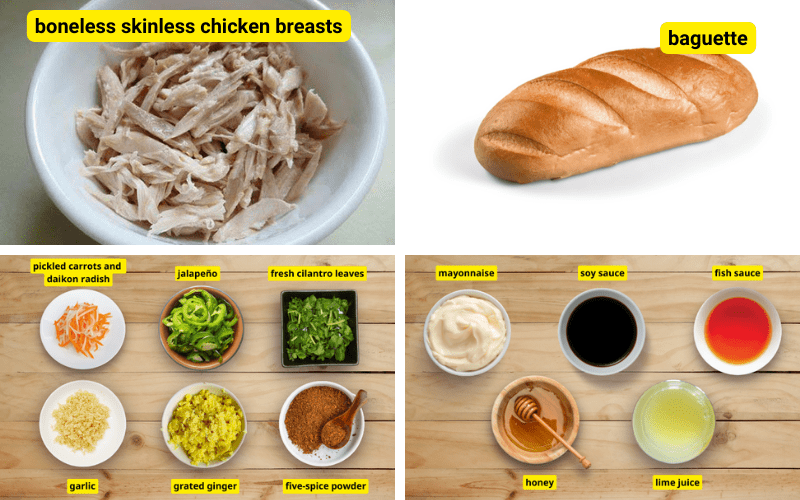
How To Make Chicken Banh Mi?
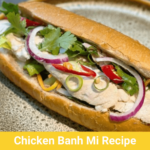
Indulge in the irresistible flavors of grilled chicken banh mi – a healthy and delicious Vietnamese sandwich packed with vibrant ingredients.
- Grill or stovetop pan
- 4 boneless, skinless chicken breasts
- 1/4 cup soy sauce
- 2 tablespoons fish sauce
- 2 tablespoons lime juice
- 2 tablespoons honey
- 4 cloves garlic, minced
- 1 tablespoon grated ginger
- 1 teaspoon five-spice powder
- 4 baguettes, preferably Vietnamese-style
- 1/2 cup mayonnaise
- 1 cup pickled carrots and daikon radish
- 1/2 cup fresh cilantro leaves
- 1 jalapeño, thinly sliced
Prepare the chicken
In a bowl, combine soy sauce, fish sauce, lime juice, honey, minced garlic, grated ginger, and five-spice powder.
Place the chicken breasts in a shallow dish and pour the marinade over them. Ensure the chicken is evenly coated.
Cover the dish and refrigerate for at least 30 minutes, allowing the flavors to infuse into the chicken.

Cook the chicken
Preheat a grill or stovetop pan over medium-high heat.
Remove the chicken breasts from the marinade, shaking off any excess.
Grill or pan-sear the chicken for about 6-8 minutes per side, or until cooked through and nicely charred.
Transfer the cooked chicken to a plate and let it rest for a few minutes before slicing.

Assemble the banh mi
Slice the baguettes lengthwise, creating a pocket for the fillings.
Spread a generous amount of mayonnaise on both sides of the baguette.
Layer the pickled carrots and daikon radish on the bottom half of the baguette.
Place the sliced grilled chicken on top of the pickled vegetables.
Garnish with fresh cilantro leaves and sliced jalapeño according to your preference.
Close the sandwich and gently press it together.

Serve and enjoy
Slice the chicken banh mi into smaller portions, if desired.
Serve the sandwiches immediately and enjoy the vibrant flavors and textures of your homemade chicken banh mi.
Feel free to customize your banh mi with additional ingredients like cucumber slices, sliced onions, or chili sauce for an extra kick.
How many calories in a chicken banh mi sandwich?
To provide an estimate of the caloric content in a chicken banh mi sandwich, let’s analyze the Vietnamese chicken banh mi calories breakdown of each component:
| Component | Calories |
| Grilled Chicken Breast (4 oz) | 124 |
| Baguette (6-inch piece) | 170 |
| Mayonnaise (1 tbsp) | 94 |
| Pickled Carrots and Daikon | 30 |
| Fresh Cilantro | 1 |
| Sliced Jalapeño | 4 |
| Total | 423 |
Please note that these values are approximate and can vary based on the specific ingredients and portion sizes used. It’s also important to consider that these calories provide an estimation of the energy content and may not reflect the overall nutritional value of the sandwich.
Analyzing the nutritional value
- Carbohydrates: The bread, typically a baguette, provides carbohydrates for energy.
- Fats: Mayonnaise, often used as a spread, contributes to the overall fat content of the sandwich.
- Nutrient Dense: Fresh vegetables and herbs offer a range of vitamins, minerals, and antioxidants that support overall health.
- Fiber: The fiber content from vegetables aids digestion, promotes satiety, and supports a healthy gut.
- Protein: Chicken provides a lean protein source, aiding in muscle repair and satiety.
- Carbohydrates: The bread provides energy through carbohydrates, which are essential for daily activities.
- Fats: While mayonnaise adds flavor and creaminess, it’s important to be mindful of portion sizes to moderate fat intake.
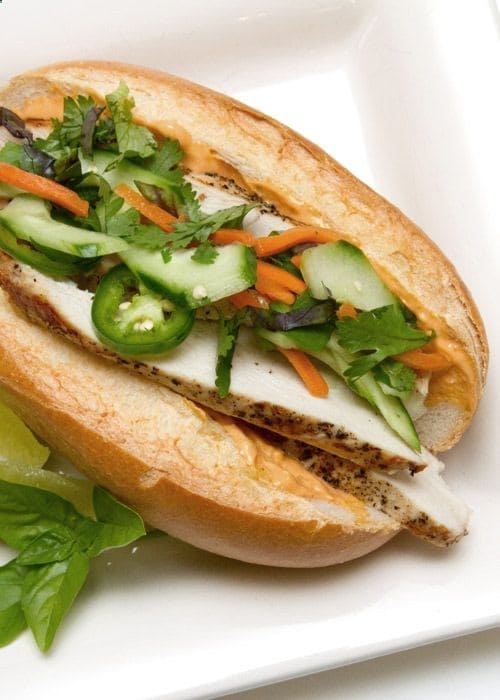
Tips for reducing caloric content
To reduce or modify the calorie content of a chicken banh mi without compromising taste, consider the following tips:
- Use skinless chicken breast and trim any visible fat to reduce overall calories.
- Opt for whole-grain or lighter bread options instead of traditional baguettes to reduce calorie intake.
- Use a light or reduced-fat mayonnaise or consider using alternative spreads like Greek yogurt or hummus.
- Control portion sizes by using smaller bread portions or sharing the sandwich with a friend.
- Increase the proportion of fresh vegetables and herbs to add bulk and nutrients without significantly increasing calorie content.
Is chicken banh mi healthy?
Yes, chicken banh mi can be a healthy choice when prepared with nutritious ingredients and consumed as part of a balanced diet. Here are a few reasons why chicken banh mi can be considered a healthy option:
- Lean Protein: Grilled chicken breast is a lean source of protein, which is essential for muscle growth, repair, and overall health.
- Fresh Vegetables: Chicken banh mi typically includes an array of fresh vegetables like pickled carrots, daikon radish, cilantro, and jalapeños. These vegetables provide essential vitamins, minerals, and dietary fiber, contributing to a well-rounded and nutritious meal.
- Balanced Flavors: The combination of flavors in chicken banh mi, including the savory chicken, tangy pickled vegetables, and aromatic herbs, creates a well-balanced taste profile that can satisfy cravings without relying on excessive fats or sugars.
- Portion Control: Controlling the portion size of the sandwich can further enhance its healthiness. Opting for a smaller-sized banh mi or enjoying a half portion alongside a side salad or vegetable dish can help maintain a balanced calorie intake.
- Customizable Ingredients: Chicken banh mi allows for customization, making it easy to adjust the ingredients according to personal preferences and dietary needs. For example, choosing whole-grain bread, reducing the amount of mayonnaise, or adding more vegetables can enhance its nutritional value.
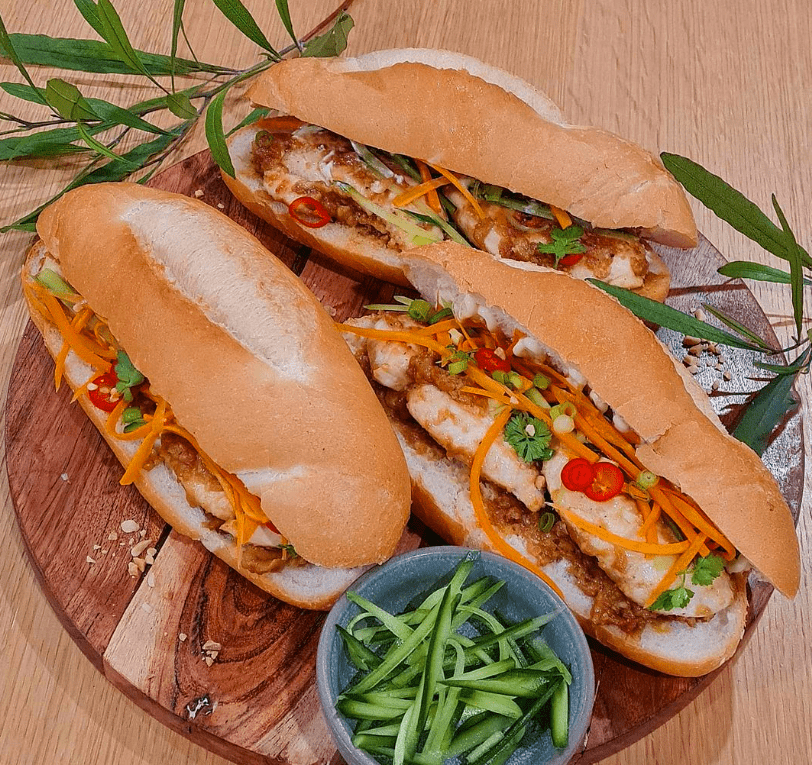
What to serve with chiken banh mi?
When serving chicken banh mi, there are several delicious accompaniments that can complement the flavors of the sandwich. Here are some popular options:
- Vietnamese Spring Rolls: Fresh and light, these rice paper rolls filled with vegetables, herbs, and shrimp or tofu are a perfect side dish to enhance the Vietnamese dining experience.
- Vietnamese Slaw: A refreshing slaw made with shredded cabbage, carrots, and a tangy dressing of rice vinegar, fish sauce, and lime juice adds a crisp texture and vibrant flavors to the meal.
- Vietnamese Iced Coffee: A sweet and strong iced coffee with condensed milk is a classic beverage choice that complements the spiciness of the banh mi and provides a cool contrast.
- Fresh Fruit: Slices of juicy tropical fruits like mango, pineapple, or papaya can serve as a refreshing and healthy accompaniment to balance the richness of the banh mi.
- Sweet Potato Fries: Crispy and flavorful sweet potato fries add a delicious twist to the meal and offer a contrast in texture to the sandwich.
- Light Salad: A side salad with mixed greens, cucumber, and a light vinaigrette can provide a refreshing and nutritious option to accompany the banh mi.
- Vietnamese Dipping Sauce: A small bowl of nuoc cham, a classic Vietnamese dipping sauce made with fish sauce, lime juice, garlic, and chili, can be served for dipping the banh mi or as a dressing for the salad.
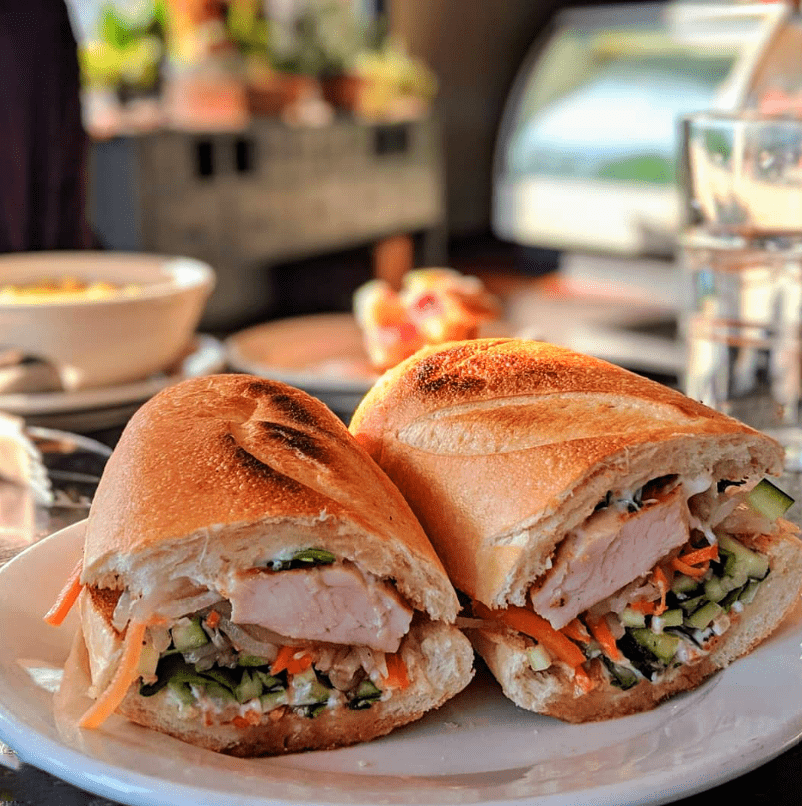
Variations of chicken banh mi
There are several delicious variations of chicken banh mi that offer unique twists on the classic recipe. Here are a few popular variations to explore:
- BBQ Chicken Banh Mi: Marinate the chicken in a tangy BBQ sauce before grilling or roasting it. The smoky flavors of the BBQ chicken add a delightful twist to the sandwich.
- Crispy Chicken Banh Mi: Instead of grilled chicken, use crispy fried chicken or breaded chicken cutlets. The crunchy texture of the chicken creates a delightful contrast with the soft bread and pickled vegetables.
- Lemongrass Chicken Banh Mi: Infuse the chicken with the fragrant flavors of lemongrass by marinating it in a lemongrass-based marinade. This variation adds a citrusy and aromatic element to the sandwich.
- Satay Chicken Banh Mi: Incorporate the flavors of Southeast Asia by marinating the chicken in a satay sauce, typically made with peanut butter, soy sauce, and spices. The creamy and nutty flavors of satay chicken make for a delicious banh mi experience.
- Spicy Chicken Banh Mi: Add some heat to your chicken banh mi by incorporating spicy elements like Sriracha or chili sauce. You can either marinate the chicken in a spicy sauce or drizzle the sandwich with a spicy mayo or hot sauce.
- Asian Slaw Chicken Banh Mi: Elevate the crunch and freshness of your banh mi by adding a vibrant Asian slaw made with cabbage, carrots, bell peppers, and a tangy dressing. The slaw adds an extra layer of texture and flavor to the sandwich.
Substitute ingredient of chicken banh mi
If you’re looking to substitute the chicken in a banh mi sandwich, here are a few alternative protein options that can provide a delicious twist:
- Tofu Banh Mi: Replace the chicken with firm tofu slices. Marinate the tofu in a flavorful sauce or spice blend before grilling or pan-searing it. Tofu adds a plant-based protein option and a unique texture to the sandwich.
- Pork Banh Mi: Use thinly sliced grilled or roasted pork as a substitute for chicken. Marinate the pork in a mixture of soy sauce, garlic, and other spices to infuse it with savory flavors. Pork banh mi is a popular variation known for its succulent and tender meat.
- Beef Banh Mi: Opt for thinly sliced grilled or stir-fried beef. Marinate the beef in a combination of soy sauce, ginger, and garlic to enhance its taste. Beef banh mi offers a heartier and robust flavor profile.
- Shrimp Banh Mi: Swap the chicken for grilled or sautéed shrimp. Marinate the shrimp in a zesty sauce with lime juice, garlic, and herbs. Shrimp banh mi adds a seafood element to the sandwich and brings a hint of sweetness.
- Vegan Banh Mi: If you prefer a vegan option, omit the meat altogether and focus on an array of flavorful vegetables and tofu-based proteins. Add marinated and grilled tofu, sautéed mushrooms, or tempeh as the main protein component.
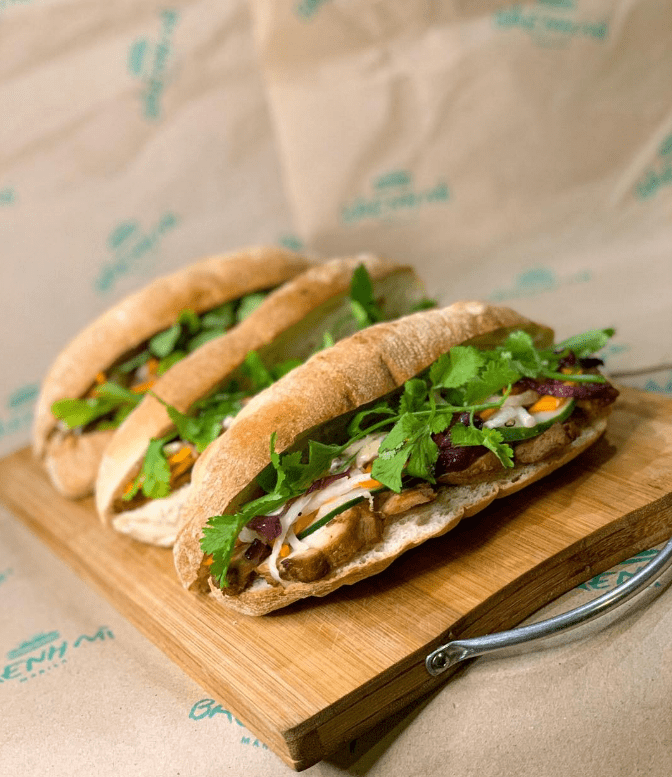
How to store chicken banh mi?
To store chicken banh mi and keep it fresh for later consumption, follow these guidelines:
Refrigeration
Wrap the chicken banh mi tightly in plastic wrap or place it in an airtight container. Refrigerate it promptly to maintain its freshness.
Separation
If possible, separate the components of the banh mi before storing. For instance, keep the pickled vegetables, sliced chicken, and bread in separate containers to prevent sogginess and maintain their individual textures.
Short-term storage
Chicken banh mi can typically be stored in the refrigerator for up to 2 days. However, it’s recommended to consume it as soon as possible to enjoy the best taste and texture.
Assembly before consumption
When you’re ready to enjoy the banh mi, reassemble the components. Spread fresh mayonnaise, add the pickled vegetables, and layer the sliced chicken onto a fresh or lightly toasted baguette. This helps retain the desired texture and taste.
Portion control
If you anticipate not consuming the entire banh mi at once, consider portioning it before storage. This way, you can easily retrieve and enjoy individual servings without compromising the freshness of the remaining sandwich.
Remember to store the banh mi in a refrigerator set to the appropriate temperature (below 40°F or 4°C) and ensure proper hygiene practices during the preparation and storage process.
Common mistakes when making chicken banh mi
When making chicken banh mi, there are a few common mistakes to watch out for. By being aware of these pitfalls, you can ensure a successful and delicious outcome:
- Overcooking the Chicken: Chicken breasts can easily become dry and tough if overcooked. Be mindful of the cooking time and temperature to ensure the chicken remains juicy and tender.
- Inadequate Marination: Marinating the chicken for an insufficient amount of time can result in bland flavors. Allow enough time for the marinade to penetrate the chicken and infuse it with the desired taste.
- Skipping the Pickled Vegetables: The pickled carrots and daikon radish are essential components of a traditional banh mi. Skipping them can result in a lack of contrasting flavors and textures, as well as a missed opportunity to add tanginess and crunch to the sandwich.
- Using the Wrong Bread: Choosing the wrong type of bread can impact the overall experience of the banh mi. Authentic banh mi is traditionally made with a Vietnamese-style baguette, which has a light and airy texture. Using a different type of bread may not provide the same level of crispness and chewiness.
- Imbalance of Flavors: Achieving a balance of flavors is crucial in banh mi. Ensure the marinade for the chicken, as well as the other components such as the mayonnaise, pickled vegetables, and herbs, are well-seasoned and in harmony with each other. Avoid overpowering one flavor component, as it can overpower the entire sandwich.
- Neglecting Fresh Herbs: Fresh cilantro is a staple in banh mi, contributing a vibrant herbaceous flavor. Neglecting to include fresh herbs can result in a loss of authenticity and freshness in the sandwich.
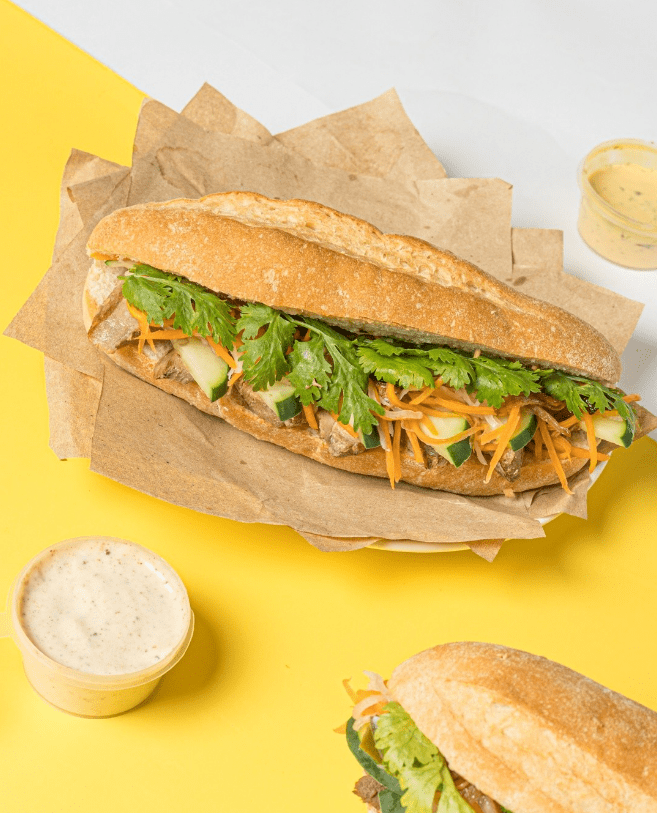
Tips for sourcing authentic Vietnamese ingredients
With these tips and tricks, you can create a chicken banh mi that is packed with authentic flavors, textures, and the overall Vietnamese culinary experience:
Tips for sourcing authentic Vietnamese ingredients
- Asian Grocery Stores: Visit local Asian grocery stores or markets that specialize in Vietnamese ingredients. These stores often have a wide variety of authentic Vietnamese products, including sauces, spices, and condiments.
- Vietnamese Markets: Look for Vietnamese markets in your area, as they are likely to have a more extensive selection of Vietnamese ingredients. These markets may carry specific herbs, vegetables, and sauces that are commonly used in Vietnamese cuisine.
- Online Retailers: Explore online retailers that specialize in Asian ingredients. They often offer a wide range of Vietnamese products and can deliver them to your doorstep, ensuring accessibility to authentic ingredients.
- Farmers’ Markets: Check if there are farmers’ markets in your area that feature Vietnamese vendors. Local growers and farmers may offer authentic Vietnamese produce and herbs that are essential for creating an authentic banh mi experience.
- Community Groups or Associations: Connect with local Vietnamese community groups or associations. They may have recommendations on where to find authentic ingredients or even host events where you can discover and purchase Vietnamese products.
Tips and tricks to make perfect chicken banh mi
- Marinating Time: Allow sufficient time for the chicken to marinate. Ideally, marinate the chicken for at least 30 minutes or even overnight, if possible. This helps the flavors to penetrate the meat, resulting in a more flavorful outcome.
- Grilling or Pan-Searing: For the best texture and flavor, consider grilling the chicken to achieve those beautiful char marks and smoky taste. If grilling is not an option, pan-searing the chicken in a hot skillet with a little oil can still yield delicious results.
- Proper Bread Selection: Choose Vietnamese-style baguettes if available, as they have a thin and crispy crust with a soft interior. The bread should be able to hold the fillings without becoming overly dense or soggy.
- Layering and Assembly: When assembling the banh mi, start by spreading a generous amount of mayonnaise on the bread, followed by pickled vegetables, chicken slices, and fresh herbs. This layering order helps distribute the flavors evenly throughout the sandwich.
- Balance of Flavors: Achieve a balance of flavors by adjusting the seasoning and ratio of ingredients. Taste as you go and adjust the amount of salt, sweetness, tanginess, and spiciness according to your preference.
- Fresh Herbs and Crunchy Vegetables: Fresh herbs, such as cilantro, provide a burst of freshness, while pickled carrots and daikon radish offer a pleasing crunch. Ensure that the herbs are fresh, and the vegetables are properly pickled for optimal taste and texture.

FAQs
Is chicken banh mi only popular in Vietnam?
Chicken banh mi originated in Vietnam and remains a beloved street food there. However, its popularity has spread globally, and it is now enjoyed in various parts of the world. It has gained a significant following due to its unique flavors and satisfying combination of ingredients.
What are the best vegetables to include in a chicken banh mi?
The best vegetables to include in a chicken banh mi are traditionally pickled carrots and daikon radish. These add a tangy and crunchy element to the sandwich. Other vegetables commonly used are sliced cucumbers, fresh cilantro leaves, and thinly sliced jalapeños for a touch of spiciness.
However, feel free to customize and add your favorite vegetables to suit your taste preferences. The key is to achieve a balance of flavors and textures that complement the chicken and the overall banh mi experience.
Can I use bone-in chicken for banh mi?
While boneless, skinless chicken breast is the most commonly used protein in banh mi, you can certainly use bone-in chicken if desired. However, bone-in chicken may require longer cooking times to ensure it is fully cooked and tender.
It’s important to adjust the cooking method accordingly, such as grilling or roasting, to ensure the chicken is cooked through and the bones do not interfere with the sandwich assembly.
Can I use gluten-free bread for a chicken banh mi?
Yes, you can use gluten-free bread as a substitute for the traditional baguette in a chicken banh mi. There are various gluten-free bread options available that can provide a suitable base for the sandwich.
Look for gluten-free baguettes or breads made from alternative flours such as rice, corn, or tapioca. Keep in mind that gluten-free bread may have a different texture and taste compared to traditional baguettes, so choose one that best suits your preferences.
Can I use pre-made pickled vegetables for banh mi?
Yes, you can use pre-made pickled vegetables as a convenient option for banh mi. Pre-made pickled carrots and daikon radish can be found in many grocery stores or Asian markets.
They offer a time-saving alternative to making your own pickled vegetables from scratch. However, if you prefer a specific flavor or texture, making your own pickled vegetables allows for customization according to your taste preferences.
How spicy is a typical chicken banh mi?
The spiciness of a typical chicken banh mi can vary depending on personal preference and the individual recipe. Traditionally, banh mi incorporates thinly sliced jalapeños, which add a mild to moderate level of spiciness. However, the level of spiciness can be adjusted based on the amount and type of chili used.
If you prefer a spicier banh mi, you can increase the quantity of jalapeños or use spicier chili varieties. Conversely, you can reduce or omit the jalapeños if you prefer a milder flavor profile. Ultimately, the level of spiciness can be customized to suit your taste preferences.
Can I use a different type of sauce for banh mi?
Yes, you can experiment with different types of sauces to add a unique flavor profile to your banh mi. While the traditional banh mi sauce is typically a combination of mayonnaise and various condiments like sriracha or chili sauce, you can get creative and try other sauces that complement the flavors of the sandwich.
For example, you could use hoisin sauce, peanut sauce, or a tangy vinaigrette as an alternative sauce option. Just keep in mind that the sauce should harmonize with the other ingredients and enhance the overall taste of the banh mi.
Can I make a spicy version of chicken banh mi?
Absolutely! If you enjoy spicy flavors, you can easily make a spicy version of chicken banh mi. One option is to increase the amount of chili or chili sauce you use in the marinade or as a condiment. You can also add additional spicy elements like sliced jalapeños or hot peppers to bring the heat.
Adjust the level of spiciness to your preference and taste buds. It’s all about finding the right balance of flavors that satisfies your spicy cravings without overpowering the other ingredients in the banh mi.
Can I add cheese to a chicken banh mi sandwich?
While cheese is not a traditional ingredient in a classic chicken banh mi, you can certainly add cheese if you enjoy the combination of flavors. Consider using mild and melty cheese, such as provolone or Monterey Jack, to complement the other ingredients.
However, keep in mind that the addition of cheese may alter the overall flavor profile of the banh mi. It’s recommended to use cheese sparingly to avoid overwhelming the other flavors that make banh mi distinctive.
How do I ensure that the chicken is cooked through in a banh mi sandwich?
To ensure that the chicken in your banh mi sandwich is cooked through, follow these steps:
- Check the internal temperature: Use a meat thermometer to verify that the chicken has reached a safe internal temperature of 165°F (74°C). Insert the thermometer into the thickest part of the chicken breast to get an accurate reading.
- Observe the color and texture: Cook the chicken until it is no longer pink in the center and the juices run clear. The meat should be firm and opaque, not translucent or rubbery.
- Cooking time and methods: Depending on the thickness and size of the chicken breast, the cooking time may vary. Grilling, pan-searing, or baking are common methods for cooking chicken for banh mi. Follow the recipe instructions and adjust the cooking time as needed based on the specific cut and thickness of the chicken.
How do I achieve the perfect balance of flavors in a chicken banh mi?
To achieve the perfect balance of flavors in a chicken banh mi, consider the following tips:
- Marinade: Ensure the chicken is properly marinated to infuse it with flavor. Use a combination of ingredients such as soy sauce, fish sauce, lime juice, garlic, and spices to create a well-rounded marinade. Adjust the quantities of each ingredient to achieve the desired flavor profile.
- Seasoning: Taste and adjust the seasoning of each component, including the chicken, pickled vegetables, and condiments. Balance the saltiness, tanginess, and sweetness according to your preference. Remember to season not only the chicken but also the overall sandwich.
- Spiciness: Control the spiciness level based on personal preference. Add sliced jalapeños, chili sauce, or sriracha to provide a hint of heat, but be careful not to overpower the other flavors.
- Texture: Pay attention to the textures in the banh mi. Aim for a combination of soft and crispy elements. Ensure the bread is crusty on the outside but soft on the inside. Use pickled vegetables for a tangy and crunchy contrast. Include fresh herbs like cilantro for added freshness.
- Condiments: Choose the right condiments to enhance the flavors. Traditional banh mi often includes mayonnaise and a chili-based sauce like sriracha. Spread these condiments in the appropriate amounts to add creaminess and a touch of spiciness.
- Freshness: Use fresh ingredients, especially when it comes to the vegetables and herbs. Freshness adds vibrancy and elevates the overall flavor profile of the banh mi.
- Taste as You Go: Regularly taste the components as you assemble the banh mi. This allows you to make adjustments and ensure that all the flavors harmonize well.
Finding the perfect balance of flavors may require some experimentation and personalization. Adjust the ingredients, seasoning, and quantities according to your taste preferences.
Conclusion
Now that we’ve reached the end, chicken banh mi stands as a delicious and satisfying Vietnamese sandwich that has captured the hearts and taste buds of people around the world. With its blend of savory grilled chicken, tangy pickled vegetables, fresh herbs, and crusty baguette, it offers a harmonious symphony of flavors and textures. This culinary masterpiece reflects the fusion of Vietnamese and French influences, showcasing the adaptability and creativity of Vietnamese cuisine.
Chicken banh mi also brings health benefits to the table, with lean protein from the chicken and a generous serving of fresh vegetables. The balance of flavors and ingredients makes it a nutritious and well-rounded meal option.
From traditional recipes to unique variations, there are endless possibilities to explore and customize your own chicken banh mi experience. Whether you enjoy it with smoky BBQ chicken, crispy fried chicken, or the classic grilled version, each bite is a delightful adventure.
So, venture into the world of chicken banh mi, discover the authentic ingredients, and savor the burst of flavors that this Vietnamese delight has to offer. Let it transport you to the bustling streets of Vietnam, where the aroma of grilled chicken and the satisfaction of a perfectly crafted banh mi fill the air. Indulge in this culinary treasure and experience the joy it brings with every mouthwatering bite.